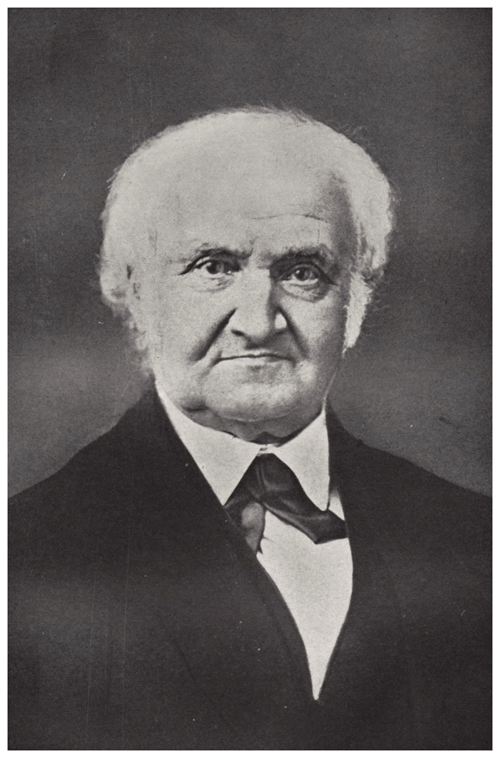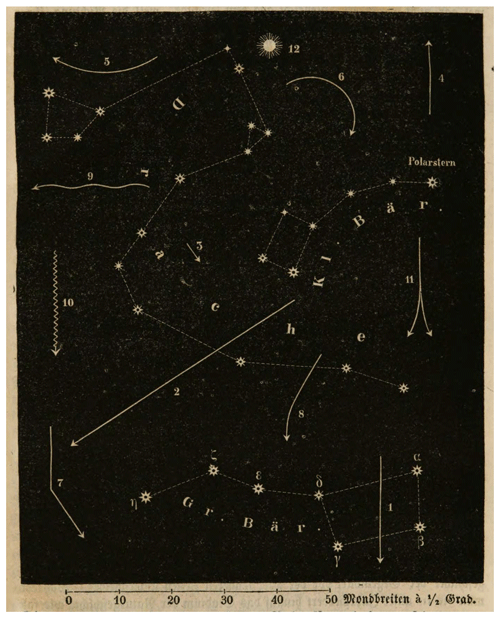the Creative Commons Attribution 4.0 License.
the Creative Commons Attribution 4.0 License.
Eduard Heis, an early pioneer in meteor research
Ulrich Sperberg
At the beginning of the 19th century, meteor observations were not well established. One of its pioneers, who observed meteors on a regular basis, was Eduard Heis in Münster, Germany. We summarise the life of this scientist. Besides his main task of teaching mathematics in Aachen and Münster, he observed atmospheric phenomena and variable stars with exceptional perseverance. He was an editor of Wochenschrift für Astronomie and contributed to the circulation of astronomical reports and knowledge. We focus on his contributions to meteor astronomy, in which he predated the work of Schiaparelli by 30 years.
- Article
(11505 KB) - Full-text XML
- BibTeX
- EndNote
Eduard Heis was born in Cologne on 18 February 1806. Until 1824, he attended the Carmelite school and studied mathematics and philology in Bonn afterwards. In an article about meteors and meteorites, Heis wrote that he saw, in 1826, a penknife, whose blade was made of celestial iron, presented by Ernst Florens Friedrich Chladni (1756–1827), the famous father of meteoritics (Heis, 1855). It is unknown where the two men met. Chladni travelled for many years through Europe and earned his livelihood with lectures about meteorites and acoustics. It is certain that Chladni visited Frankfurt in January and February 1826 (Ullmann, 1996). Chladni himself wrote that he visited the geologist and mineralogist Johann Jakob Nöggerath (1788–1877) in 1829 in Bonn (Chladni, 1826). It is possible that this meeting was one reason why Heis dealt intensively with meteors and fireballs later on.
After graduating, he became a mathematics and physics teacher at the Friedrich Wilhelms Gymnasium in his hometown and later on at the Bürger- und Provinzial-Gewerbeschule (vocational school) in Aachen. This was where he started, inspired by Friedrich Argelanders, as part of “Aufforderung an Freunde der Astronomie” (Request to friends of astronomy; Argelander, 1844), observing meteors from the roof of the school building. According to Klein (1877), who was one of his students, it was von Boguslawski (1789–1851) who sparked Heis's interest in meteors in 1839.
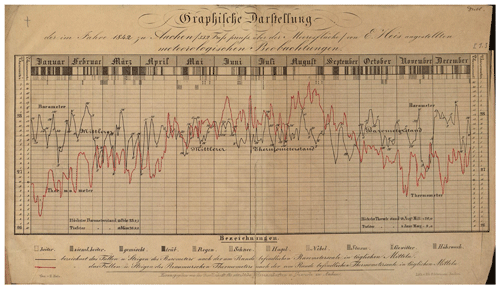
Figure 2Weather observations in Aachen in 1842 done by Heis. (Digital Collection of the Universitäts- und Landesbibliothek Münster; urn:nbn:de:hbz:6:1-244588. Creative Commons – Public Domain Mark 1.0).
He was also interested in variable stars, the Milky Way, zodiacal light, and atmospheric and meteorological phenomena (Fig. 2).
He married Margareta Will in 1833 and had five children with her; two of them died young (Plaßmann, 1930).
In 1852, he was appointed as professor of mathematics and astronomy, promoted by Friedrich Wilhelm Argelander and Alexander von Humboldt at the Königliche Theologische und Philosophische Akademie (later the University of Münster). In 1869, he was elected as rector of the university.
Also, in his time in Münster, he observed meteors, polar lights, halos, variable stars, and other phenomena, mainly with naked eye. He could use only a small 4 in. (10.6 cm) telescope on the roof of the academy. Heis was favoured with an unusually keen sight and, therefore, could see far more than ordinary observers with unassisted eyes (Dunkin, 1877). In his later years, health problems prevented him from observing (Heis, 1877b, p. 138). He was well known for his textbooks in mathematics, but he also published astronomical books, e.g. the Atlas Coelestis Novus, with 12 charts, in 1872 and the booklet Die periodischen Sternschnuppen und die Resultate der Erscheinungen, abgeleitet aus den während der letzten 10 Jahre zu Aachen angestellten Beobachtungen, with an analysis of 1761 plots of meteors.
Heis was nominated as a foreign associate of the Royal Astronomical Society in London in 1874 and as an honourary member of the Deutsche Akademie der Naturforscher Leopoldina in Halle (the oldest German Academy of Science) in 1877 (Butzer, 2014).
He died on 30 June 1877 after a stroke.
Some English biographies of Eduard Heis already exist (Butzer, 2014; Dunkin, 1878; Rigge, 1906). These describe him essentially and in general as an astronomer.
It is not the aim of this article to add another contribution to that canon, but rather to focus on his meteor observations and his research on the subject, since a general history of meteor astronomy of the late 18th and 19th centuries is still not available. For this purpose, his publications and those of his contemporaries, as well as obituaries, have been studied in detail. Many of his publications have been unjustly forgotten today. This is also true for a number of illustrations, some of which are reproduced here. The biographical information in the first chapter is mainly based on the above-mentioned publications.
His hypothesis of the luminosity of meteors seems interesting. He realised that the periodically returning meteor showers (in this case, the Perseids and the Leonids but also the Orionids, Geminids and Quadrantids) are often accompanied with another, independent shower from a different region of the sky. The trails of the meteors of both showers intersect in angles of 90∘ or smaller (Fig. 3).
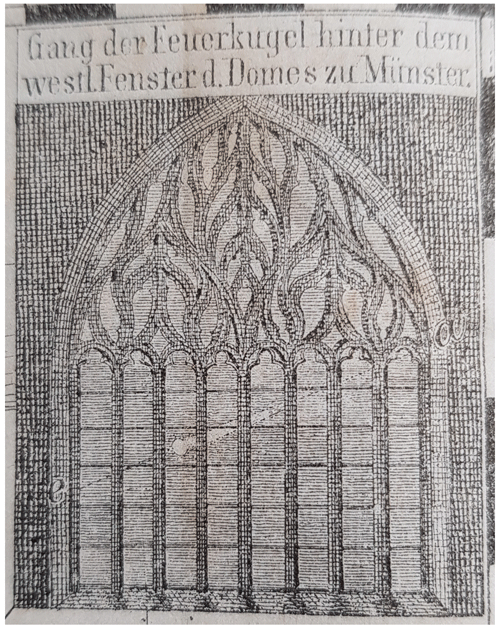
Figure 6One of the most remarkable pictures of a fireball observed on 4 March 1863 through the window of the Münster cathedral (Heis, 1863b).
Heis explained the following:
Das Gegeneinanderbewegen und Durchdringen der Sternschnuppenströme erklärt aber auch… das Aufläuchten der Sternschnuppen und die Bildung der raketenartigen Schweife; sei es nun , dass durch das Aneinanderreiben und Gegeneinanderstossen der meteorischen Körper sich Wärme entwickelt, welche bei der grossen Geschwindigkeit nicht als unbedeutend anzunehmen ist, oder… dass eine chemische Einwirkung statt findet. (The motion of one stream against the other and their penetration also explains the lighting up of the meteors and the formation of the rocket-like tails. This may be due to the formation of heat by friction or hitting of the meteoritic bodies with each other, which is assumed to be non-insignificant. Also, a chemical reaction could take place.) (Heis, 1849, p. 38)
From the composition of meteorites, he concluded that the matter of one stream consists of “regulinic” (native) iron and the second one mainly of solid sulfur. When the particles of both showers collide, a chemical reaction takes place and light and heat are emitted. Depending on the nature of the iron and sulfur streams, we can observe common meteors, nebulous ones, or ones with long-lived tails that are straight, curved, or even meandering (Fig. 4).
The results of Heis' lifelong meteor observations were published shortly after he passed away in the book Resultate der in den 43 Jahren 1833–1875 angestellten Sternschnuppen-Beobachtungen (Results of 43 years of meteor observations, from 1833–1875; Heis, 1877b). Therein the reader finds coordinates of the start and end points, as well as the brightness of about 15 000 meteors. Regarding the meteoroid streams Heis (1849, p. 7) expressed the following: “Dieses Ausgehen von einem Punkte aus deutet darauf hin, dass tausende der kleinen Weltkörper… vereint dieselbe Richtung im Weltraume verfolgen, dass sie in Gemeinschaft eine Bahn um die Sonne beschreiben…” (Starting from the same point indicates that thousands of the celestial bodies … together follow the same direction in space, which they describe as a whole an orbit around the Sun). This confirmed the following theory expressed by Erman (1839): “dass dieselben, keinen isolierten Haufen bildend, in einer Anzahl von Myriaden einen geschlossenen Ring bilden, der die Erdbahn in einem bestimmten Punkte berührt” (that these same entities are not forming an isolated cluster but rather myriads of them forming a close ring, which touches the Earth orbit at a specific point.)
Schiaparelli's (1871) discovery that the orbits of certain meteor showers were identical with those of certain comets was based on the work done by Heis. Schiaparelli donated an exemplar of the first German edition to Heis with a letter, showing his deference to him:
… tres honore Proffesseur, Je me prends la liberte de vous envoyer, en mon nom, et en nom du traducteur, un exemplaire d'un ouvrage sur les etoiles filantes, publie il y quelques jours en langue allemande: je crois remplir par la un devoir envers Vous, qui avez toujours cultive cette etude avec amour et perseverance, meme lorsque elle n'etait guere en vogue. (… most honourable professor, I take the liberty of sending you, on my behalf and on behalf of the translator, a copy of a book on shooting stars, published a few days ago in German. I believe that I am fulfilling a duty to you, who have always cultivated this study with love and perseverance, even when it was not in vogue.) (Plaßmann, 1930, p. 292)
The popularisation of scientific knowledge in general and astronomy in particular was a matter close to his heart.
In 1855, he was one of the founding editors of the Journal Natur und Offenbarung, Organ zur Vermittlung zwischen Naturforschung und Glauben für gebildete aller Stände (Nature and revelation, press organ for mediation between nature research and religion for educated classes). At the beginning of each volume there are announcements to the readers, which provide information about the aims of the journal and the perception the editors wanted readers to have of their publication. These announcements provide us with a unique possibility to learn more about the way of thinking of Eduard Heis. It is unknown whether Heis or one of the other editors wrote these pages, but what is for sure is that Heis stood behind them. The publication is named as an undertaking “for [a] principal fight against materialism as a seemingly scientific force” and the “initiation of a true reconciliation of belief an ongoing knowledge” (Anonym, 1860). In another volume, we read the following:
… wir haben auch von Anfang an dieses rein wissenschaftliche Strohfeuer des hellaufflackernden Materialismus nicht als die Krankheit, sondern nur als ein Symptom der Krankheit, höchstens als ein Exanthem an dem kranken Körper der Gegenwart betrachtet. Die Krankheit ist jene Schwäche des Denkens in der Gesammtheit… (… we have also considered from the beginning the bright flare up of the materialism to be just a scientific passing fancy, not an illness, only a symptom of illness, an exanthema on a sick body. This illness is the weakness of thinking in the present time in entirety…) (Anonym, 1862)
It is necessary to know that Heis was a lifelong devout Catholic, so he dedicated his Atlas Coelestis Novus (Heis, 1872) to Pope Pius IX and Father Angelo Secchi (Society of Jesus). During the First Vatican Council, he stood faithfully by the church (Butzer, 2007).
For about 20 years, from 1857 to 1877, he was the editor of the Wochenschrift für Astronomie, Meteorologie und Geographie (Weekly journal for astronomy, meteorology and geography) in Halle (Fig. 5). The mixture of journalistic and scientific reports was made to educate and entertain the readers, who were both scientists and amateurs (Wilson, 2006; Vierteljahresschrift, 1877). Especially in the first years, both journals provided imprints of a high quality (Figs. 6 and 7). These journals compiled a number of contemporary astronomical and meteorological records which have been benefitted modern science as well (e.g. Wilson, 2006; Diercke et al., 2015; Hayakawa et al., 2018). Heis also collected astronomical reports from all over the world, as exemplified with the aurora accounts, and published them in this journal (e.g. Wilson, 2006; Hayakawa et al., 2020).
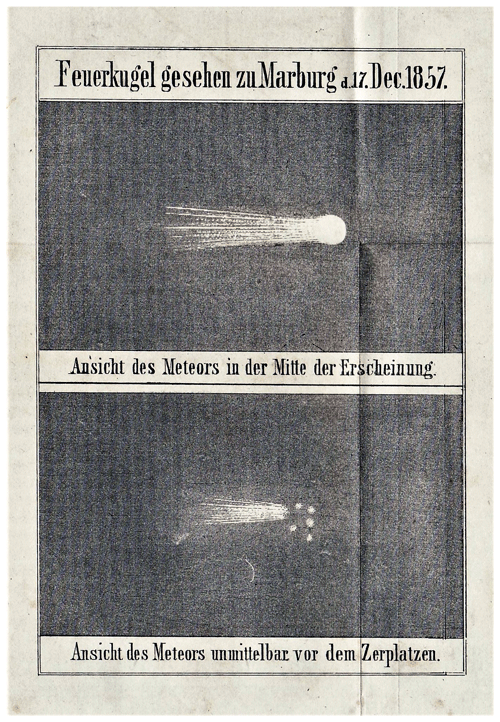
Figure 7The two phases of the fireball observed on 17 December 1857 at Marburg (Heis, 1858; plate 1).
The following is an anecdote which Heis liked to tell demonstrate his popularity:
… when he travelled to Italy, near Gotthard mountain pass, Heis enjoyed the clear night beside the coachman. Suddenly, a bright meteor appeared. The coachman said, “It will be fine if Prof. Heis has also seen this meteor,” and Heis insisted that the professor had seen it. But the coachman explained that Professor Heis lives in Münster, and so it will be impossible for him to see a meteor south of the Gotthard pass. Heis repeated that he had seen it. The driver then realised that the strange traveller was the known professor from Münster. (Plaßmann, 1930, p. 295)
Eduard Heis did not carry out his meteor observations alone. In his publication (Heis, 1877b), he gives us an exact description of an observational session.
The sky was divided in five parts, namely north, east, south, west, and zenith. Each of these regions was manned by two or three observers. Additionally, there were one or two leaders. A secretary wrote down the following data of each meteor: time (hour, minute, and often also seconds), brightness, circumstances (this means colour, tail, and angular velocity), trail, and direction (Heis, 1849, 1859). All in all, there were 12 to 17 observers in one session. Indeed, in Heis's report of the Perseid observations in 1858, he wrote that, in Münster, 16 people conducted the observation, alternating with each other, followed by a list with names of 23 students of the academy (Heis, 1858).
The trail of a meteor was reported by the observer to Heis, who plotted it as an arrow in the star chart. Especially in regions of the sky where stars are rare, the observers used a 6 ft (1.9 m) long white pole to point out the beginning and end points of the meteor's trail. The charts from Riedig, based on Bodes's Uranographia (Riedig, 1841) are used. Because these charts are not gnomonic ones, the trails of the meteors must not be straight lines but rather curves. Later on, Heis published his own charts, which were selected for Leonid observations in November (Heis, 1868, Fig. 8). In an announcement, he wrote the following:
Encouraged by some members of the Astronomische Gesellschaft, for convenience, I have designed five charts drawn of the meteors in the November period and printed them lithographically. They are suitable for the precise drawing of meteor trails to determine the radiant points as well as for calculations of the absolute heights of the meteors. (Heis, 1867b)
Another method was to draw the meteors' paths with chalk on a 30 in. (78 cm) black wooden globe. Up to 300 trails were secured for further investigations in this way. The determination of time in the middle of the 19th century was difficult. Eduard Heis tried an uncommon method. On 18 October 1851, he used the electric telegraph of the Rheinische Eisenbahn (railway company) to allow communication between the observers at the two stations in Aachen and Herbesthal so that they could notify each other about single meteors (Klein, 1877). Later on, in 1854, again he used the telegraph of the Westfälische Eisenbahn (railway company) for simultaneous observations in Münster and Hamm (Heis, 1877b). The observation took place in front of the station buildings.
Heis never saw the southern sky, but he was one of the first who encouraged other to observe meteors in the Southern Hemisphere, e.g. George Neumayer in Australia. Together, they published the results (Heis and Neumayer, 1867).
Also for members of other expeditions, he provided hints for meteor observations, e.g. the 1874 transit of Venus expeditions (Heis, 1874) and Clemens Denhardt's expedition to eastern equatorial Africa (Heis, 1877a)1. Despite there being some arrangements with participants of the German transit of Venus expeditions (Heis, 1874), these only rarely resulted in observations. In the official report of the voyage of S.M.S. Gazelle (Hydrographisches Amt des Reichs-Marine-Amts, 1889), we read that also navy officers were instructed to make observations.
So waren Herrn Kapitänlieutenant Dietert, Herrn Lieutenant zur See Rittmeyer und Herrn Unterlieutenant zur See von Seelhorst die atmosphärischen, d. h. die meteorologischen und astronomisch-physikalischen (Zodiakal-Licht, Nord- und Südlicht, Meteore usw.) übertragen. (Captain Lieutenant Dietert, Lieutenant Rittmeyer and Sub-Lieutenant von Seelhorst were responsible for the atmospheric, i.e. the meteorological and astronomical–physical aspects (zodiacal light, northern and southern light, meteors, etc.)
The most extensive list of meteors was from the assistant of the expedition to Mauritius, Dietrich Heidorn (1833–1893), calculator at Göttingen Observatory (Schur, 1894), who observed, on 3 d in November and December 1884, 60 meteors and some more on other days, which are described only in general (Heidorn, 1875). Another German expedition led to Port Ross (Auckland Island), where Hermann Krone from Dresden acted as the photographer (Duerbeck, 2004). He wrote,“Sternschnuppen und Meteoriten sind uns während der ganzen Reise wenig zu Gesicht gekommen”, and the following later on:
… obgleich wir gerade am 10 August die beste Gelegenheit gehabt hätten, den Laurentiusstrom unter dem Aequator zu beobachten und in dieser Absicht den Abend- und Nachtstunden mit grossem Interesse entgegengesehen hatten, so wurden unsere Erwartungen leider bitter enttäuscht, denn gerade am Abend des 10 August wurde bis tief in die klare, sternhelle Nacht hinein nicht eine einzige Sternschnuppe sichtbar. (Shooting stars and meteorites [sic] were only rarely seen by us during the whole journey. Despite having the best opportunities on 10 August to observe the Laurentius shower below the Equator, and we looked forward to the evening and night hours with great interest, our expectations were unfortunately bitterly disappointed. On the evening of 10 August, not a single one shooting star was visible despite it being a clear and starry night.) (Krone, 1879)
This is somewhat surprising. In the first half of August, not only are the Perseids active, but also, e.g., the Alpha Capricornids and the southern Delta Aquariids. Meteors should have been seen frequently.
The main objectives of meteor observation in the middle of the 19th century were (i) the determination of the daily rate, (ii) the determination of the radiant points, and (iii) the determination of the altitude of the meteor trails.
In terms of all of these points, Heis made significant contributions. The determination of the variation of daily rate seems to be easy, but it was not. It must be taken into account that different observers have different perceptions, and also the quality of the sky is different. Heis published a summary of his data (in 1849 and more extensively in 1877b) but critically remarked:
Ich bin nicht in den Stand gesetzt aus meinen Beobachtungen, die sich selten bis auf die Morgenstunden erstreckten, eine Reihe von Angaben über die stündliche Anzahl der Meteore um Mitternacht zu geben. Ich habe Scheu getragen aus der Zahl der von einem Beobachter… durch Ueberschlag oder Rechnung einen Schluss auf die Menge der Sternschnuppen zu machen, welche am ganzen Himmel erscheinen. (From my observations, which rarely extended into the morning hours, I am not in a position to give a series of data on the hourly number of meteors at midnight. I have shied away from making a conclusion from the number of shooting stars by an observer on the quantity of shooting stars, which appear in the whole sky, either by estimation or calculation).
He explicitly mentions Schmidt's list (1876) as being the most trustworthy. In addition, he gave lists of the radiant points in the process of the year (Heis, 1849, 1863a, 1867a, 1877b).
The different methods for the determination of the altitude of a meteor are described by Reimann (1879) in his dissertation, beginning with the first raw determinations of Brandes and Benzenberg (1798), based on their own observations, the methods of Quetelet (1837) and Bessel (1839), and also the graphic method of Heis (1849). After Heis finally finished his meteor observations, he emphasised again that, in his opinion, this method is not only time saving but also, due to the limited accuracy of the observations, of adequate precision (Heis, 1877b, p. 148). To determine the altitude, it is necessary to make observations at, at least, two different locations. Heis used a network of observers; one of them was Julius Schmidt (1825–1884) in Bonn. In Heis's publication of 1877, he provided a list of 271 meteors with their beginning and end heights. As mean values of beginning height, he gave 14 to 15 geographic miles, equal 103 to 111 km, and end heights of 9 to 10 geographic miles, equal 67 to 74 km. This is in good accordance with actual values (e.g. Yamamoto et al., 2005).
The influence of Eduard Heis on modern meteor astronomy is largely unknown today. Unlike his observations of auroras and sunspots, his extensive meteor observations have not yet been evaluated according to today's standards. Due to the high quality of the data, which have been published in full, they offer the possibility to complement the development of meteor streams with observations at least 50 years further into the past.
No data sets were used in this paper.
The contact author has declared that there are no competing interests.
Publisher’s note: Copernicus Publications remains neutral with regard to jurisdictional claims in published maps and institutional affiliations.
The author would like to thank Kristian Schlegel, for his encouragement to improve and complete this article, and an anonymous reviewer, for his valuable comments.
This paper was edited by Kristian Schlegel and reviewed by Jurgen Rendtel and two anonymous referees.
Anonym: Ankündigung, Natur und Offenbarung – Organ zur Vermittlung zwischen Naturforschung und Glauben, 6, 1860.
Anonym: Ankündigung, Natur und Offenbarung – Organ zur Vermittlung zwischen Naturforschung und Glauben, 8, 1862.
Argelander, F.: Aufforderung an Freunde der Astronomie zur Anstellung von eben so interessanten und nützlichen, als leicht auszuführenden Beobachtungen mehrere wichtiger Zweige der Himmelskunde, in: Schumacher HC (Hrsg.): Jahrbuch für 1844, Cottasche Buchhandlung Stuttgart und Tübingen, 1844.
Bessel, F. W.: Ueber Sternschnuppen, AN, 16, 221–250, 1839.
Butzer, P. L.: Heis, Edward, in: Biographical Encyclopedia of Astronomers, edited by: Hockey, T., Springer, New York, 924–926, 2014.
Chladni, E. F. F.: Ueber Zusammensetzung der Meteormassen, 1. Weitere Nachrichten von den grossen Bitburger Gediegeneisenmassen, gegeben von den Hrn. Steininger und Nöggerath, und nebst einigen Bemerkungen, Schweigger's Journal für Chemie und Physik, 46, 385–396, 1826.
Diercke, A., Arlt, R., and Denker, C.: Digitization of sunspot drawings by Spörer made in 1861-1894, Astronomische Nachrichten, 336, 53–62, https://doi.org/10.1002/asna.201412138, 2015.
Duerbeck, H. W.: The German transit of Venus expeditions of 1874 and 1882: organisation, methods, stations, results, J. Astro. History and Heritage, 7, 8–17, 2004.
Dunkin, E.: Professor Edward Heis, The Observatory, 1, 137–139, 1877.
Erman, A.: Ueber die Sternschnuppen der Augustperiode aus Beobachtungen derselben im Jahre 1839, AN, 17, 4–16, 1839.
Heidorn, D.: Beobachtung von Sternschnuppen zu Solitude (Mauritius), Wochenschrift für Astronomie, Meteorologie und Geographie, Neue Folge, 18, 99–101, 1875.
Hayakawa, H., Ebihara Y., Hand D. P., Hayakawa, S., Kumar S., Mukherjee S., and Veenadhari B.: Low-latitude Aurorae during the Extreme Space Weather Events in 1859, The Astrophysical Journal, 869, 57, https://doi.org/10.3847/1538-4357/aae47c, 2018.
Hayakawa, H., Ribeiro J. R., Ebihara, Y., Correia, A. P., and Sôma, M.: South American auroral reports during the Carrington storm, Earth Planet. Space, 72, 122, https://doi.org/10.1186/s40623-020-01249-4, 2020.
Heis, E.: Graphische Darstellung der im Jahre 1842 zu Aachen/ 552 Fuss preuss. über der Meeresfläche/ von E. Heis angestellten meteorologischen Beobachtungen/ Gez. v. E. Heis, Herausgegeben von der Gesellschaft für nützliche Wissenschaften u. Gewerbe zu Aachen, 1842.
Heis, E.: Die periodischen Sternschnuppen und die Resultate der Erscheinungen, abgeleitet aus den während der letzten 10 Jahre zu Aachen angestellten Beobachtungen, M. DuMont-Schauberg'sche Buchhandlung, Köln, 1849.
Heis, E.: Die Sternschnuppen, Feuerkugeln und Meteorsteine, Natur und Offenbarung, 1, 12–20, 1855a.
Heis, E.: Die Sternschnuppen, Feuerkugeln und Meteorsteine, Natur und Offenbarung, 1, 216–227, 1855b.
Heis, E.: Grosse Feuerkugel am 17. December 1857, Natur und Offenbarung, Wochenschrift für Astronomie, Meteorologie und Geographie, Neue Folge, 1, 54–55, 1858.
Heis, E.: Resultate der Sternschnuppen-Beobachtungen der August-Periode 1858 von Herrn Prof. Heis, Astronomische Nachrichten, 50, 145, 1859.
Heis, E.: List of Radiant Points of Shooting-Stars, MNRAS, 24, 212–215, 1863a.
Heis, E.: Die Feuerkugel am Abende des 4. März 1863 in Deutschland, Holland, Belgien und England, Natur und Offenbarung, Bd., 9, 271–285, 1863b.
Heis, E.: Die Radiationspunkte der Sternschnuppen, AN, 69, 157–160, 1867a.
Heis, E.: Sterncharten zur Einzeichnung der Sternschnuppen der November-Periode, AN, 70, 125, 1867b.
Heis, E.: Sammlung von fünf Sterncharten für die Himmelsgegenden: Nord, Ost, Süd, West und für das Zenith, zum Einzeichnen der Sternschnuppen der November-Periode, M. DuMont-Schauberg'sche Buchhandlung, Köln, 1868.
Heis, E.: Atlas Coelestis Novus (Neuer Himmels-Atlas), Pp. xiii (13) 181, Cologne, DuMont-Schauberg, 1872.
Heis, E.: Beobachtungen, deren Anstellung den Mitgliedern der Expedition zur Beobachtung des Durchganges der Venus anempfohlen wird, Münster o.J., 1874.
Heis, E.: Instruction zu den astronomischen Beobachtungen, deren Anstellung der Expedition des Herrn Clemens Denhardt zur Förderung der Erschließung von Ost-Aequatorial-Afrika anempfohlen wird, Berlin, 1877a.
Heis, E.: Resultate der in den 43 Jahren 1833-1875 angestellten Sternschnuppen-beobachtungen, Münster, Aschendorff'sche akademische Buchdruckerei, 1877b.
Heis, E.: Atlas coelestis zodiacalis ad usum observatorum Luminus Zodiacalis, Memorie della Societa Degli Spettroscopisti Italiani, 6, 77–80, 1877c.
Heis, E. and Neumayer, G.: On Meteors in the Southern Hemisphere, Mannheim, 1867.
Hydrographisches Amt des Reichs-Marine-Amts (Ed.): Die Forschungsreise der S. M. S. “Gazelle” in den Jahren 1874 bis 1876, Teil 1. Der Reisebericht, Ernst Siegfried Mittler und Sohn, Berlin, 1889.
Klein, H. J.: Sternschnuppenbeobachtungen von Prof. E. Heis, Wochenschrift für Astronomie, Meteorologie und Geographie, Neue Folge. 20, 313–317, 1877.
Krone, H.: Beobachtungen über das Zodiakallicht, Sternschnuppen und Polarlichter 1874 auf der Reise nach der Auckland-Insel, Wochenschrift für Astronomie, Meteorologie und Geographie, Neue Folge, 22, 21–28, 1879.
Plaßmann, J.: Eduard Heis, in: Westfälische Lebensbilder, edited by: Bömer, A. and Leunenschloß, O. Hauptreihe Bd.1, Heft 2, 275–304, Aschendorffsche Verlagsbuchhandlung, Münster, 1930.
Quetelet, A.: Sur les étoile filantes, Correspondance mathématique et physique, 9, 180–194, 1837.
Ratcliff, C.: The Transit of Venus Enterprice in Victorian Britain, Univ. Pittsburgh Press, Pittsburgh, 2016.
Reimann, E.: Die Höhenbestimmung der Sternschnuppen, Inaugural-Dissertation, F. W. Jungfer, Breslau, 1870.
Riedig, M.: Stern-Karten in 20 Blättern nach Bode's Uranographien in einem kleineren Maasstabe dargestellt, Leipzig, Schreibers Erben, 1841.
Rigge, W. F.: Edward Heis, Popular Astronomy, 14, 332–335, 1906.
Schiaparelli, J. V.: Entwurf einer Astronomischen Theorie der Sternschuppen, Stettin, Th. von der Nahmer, 1871.
Schmidt, J. F. J.: Ueber Meteore, AN, 88, 321–348, 1876.
Schur, W.: Todes-Anzeige, AN, 134, 215, 1894.
Ullmann, D.: Chladni und die Entwicklung der Akustik von 1750-1860, Basel, Boston, Berlin, Birkhäuser, 1996.
Vierteljahresschrift: Nekrolog Eduard Heis, Vierteljahresschrift der Astronomischen Gesellschaft, 12, 172–174, 1877.
Wilson, L.: Excerpts from and Comments on the Wochenschrift für Astronomie, Meteorologie und Geographie, Neue Folge, zweiter Jahrgang (new series 2), Adv. Space Res., 38, 304–312, https://doi.org/10.1016/j.asr.2006.07.004, 2006.
Yamamoto, M.-Y., Toda, M., Higa, Y., Maeda, K., and Watanabe, J.-I.: Altitudinal distribution of 20 persistent meteor trains: Estimated derived from Metro Campaign archives, Earth Moon Planets, 95, 276–287, doi:10.1007/s11038-005-9048-4, 2004.
More details on the transit of Venus expeditions can be found in, e.g., Ratcliff (2016).





